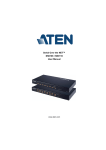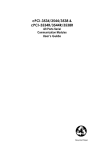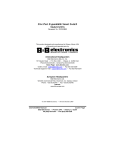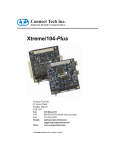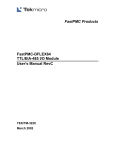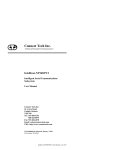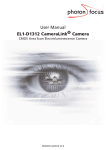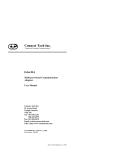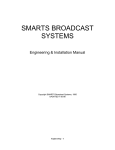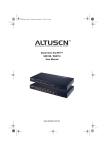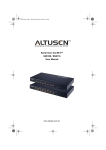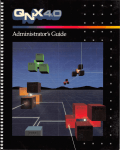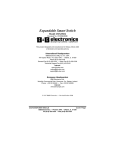Download Connect Tech DFlex-4/104 User manual
Transcript
Connect Tech Inc. “Meeting your objectives ... by design” DFlex-4/104 Multi-port Serial Communications Adapter User Manual Connect Tech Inc 42 Arrow Road Guelph, Ontario N1K 1S6 Tel: (519) 836-1291 1-800-426-8979 Fax: (519) 836-4878 Email: [email protected] FTP: ftp.connecttech.com URL: http://www.connecttech.com CTIM-00144, Revision 0.04 February 26 2001 Part Number: MAN045 DFlex-4/104 User's Manual, ver. 0.04 DFlex-4/104 User's Manual, ver. 0.04 Warranty i LIMITED WARRANTY Connect Tech Inc. warrants to the original purchaser of this Connect Tech hardware product that it is to be in good working order for a period of one year from the date of purchase from Connect Tech Inc. or an authorized Connect Tech dealer. Should this product, in Connect Tech Inc.'s opinion, fail to be in good working order during the warranty period, Connect Tech Inc. will, at its option, repair or replace this product at no charge, provided that the product has not been subjected to abuse, misuse, accident, disaster or non Connect Tech Inc. authorized modification or repair. You may obtain Limited Warranty service by delivering this product to an authorized Connect Tech dealer or to Connect Tech Inc. along with proof of purchase. If this product is shipped, you agree to insure the product or assume risk of loss or damage in transit, and to prepay shipping charges to the warranty repair location. The above warranty is the only warranty authorized by Connect Tech Inc. UNDER NO CIRCUMSTANCES WILL CONNECT TECH INC. BE LIABLE IN ANY WAY FOR ANY DAMAGES, INCLUDING ANY LOST PROFITS, LOST SAVINGS OR OTHER INCIDENTAL OR CONSEQUENTIAL DAMAGES ARISING OUT OF THE USE OF, OR INABILITY TO USE, SUCH PRODUCT DFlex-4/104 User's Manual, ver. 0.04 ii Copyright/Trademarks Copyright Notice The information contained in this document is subject to change without notice. Connect Tech shall not be liable for errors contained herein or for incidental consequential damages in connection with the furnishing, performance, or use of this material. This document contains proprietary information that is protected by copyright. All rights are reserved. No part of this document may be photocopied, reproduced, or translated to another language without the prior written consent of Connect Tech, Inc. Copyright 1987, 1988, 1989, 1990, 1996, 1997, 1998 , 1999 and 2001 by Connect Tech, Inc. Trademark Acknowledgment Connect Tech, Inc. acknowledges all trademarks, registered trademarks and/or copyrights referred to in this document as the property of their respective owners. Not listing all possible trademarks or copyright acknowledgments does not constitute a lack of acknowledgment to the rightful owners of the trademarks and copyrights mentioned in this document. DFlex-4/104 User's Manual, ver. 0.04 Certification iii Certification DFlex-4/104 The DFlex-4/104 is to be included into a device ultimately subject to FCC, DOC/IC, and CE certification. The customer is responsible for bringing the completed device into compliance prior to resale. DFlex-4/104 User's Manual, ver. 0.04 DFlex-4/104 User's Manual, ver. 0.04 Contents v Table of Contents Chapter 1: Introduction Introduction .................................................................................1-1 Manual Overview........................................................................1-1 Conventions & Symbols.....................................................1-2 Product Overview .......................................................................1-3 DFlex-4/104 Adapter..........................................................1-3 DFlex-4/104 Software ........................................................1-6 Customer Service Overview .......................................................1-6 RMA Overview...........................................................................1-9 Chapter 2: Hardware Installation Introduction .................................................................................2-1 Configuration ..............................................................................2-1 Port Addresses ....................................................................2-2 Status Port Addresses ................................................2-3 Custom Port Addresses..............................................2-4 Interrupt Selection ..............................................................2-6 Mode 1 (one IRQ)......................................................2-7 Mode 2 (two IRQs)....................................................2-9 Mode 3 (four IRQs) .................................................2-11 Baud Rate Selection .........................................................2-12 Serial Line Interface Modules (SLIM).............................2-15 SLIM Installation.....................................................2-15 SLIM compatibility .................................................2-18 Installing the DFlex-4/104 Adapter in your System ........2-18 Chapter 3: Software Installation Introduction .................................................................................3-1 Configuration ..............................................................................3-1 DOS 3.XX - 6.XX ..............................................................3-1 Linux...................................................................................3-2 Multiuser DOS 7 GOLD ....................................................3-2 OS/2....................................................................................3-2 QNX 2.XX..........................................................................3-2 QNX 4.XX..........................................................................3-3 SCO Unix ...........................................................................3-3 Windows 3.XX ...................................................................3-3 Windows 95/98...................................................................3-3 Windows NT ......................................................................3-4 Utilities........................................................................................3-4 Portfind ...............................................................................3-4 Porttest................................................................................3-4 SeePORT ............................................................................3-4 DFlex-4/104 User's Manual, ver. 0.04 vi Contents Chapter 4: Appendices Appendix A: Specifications ........................................................4-1 Operating Environment ......................................................4-1 Power Requirements...........................................................4-1 PC Bus Interface.................................................................4-1 Communications.................................................................4-1 Control Signals ...................................................................4-2 Dimensions .........................................................................4-2 Connectors/Interface ..........................................................4-2 Part Numbers ......................................................................4-2 Certification........................................................................4-2 Appendix B: Connectors/Pinouts................................................4-3 Port Connector Pinouts.......................................................4-3 Cable Connector Pinouts ....................................................4-4 Power Connector Pinouts ...................................................4-5 SLIM Pinouts .....................................................................4-6 Appendix C: Factory Settings .....................................................4-7 I/O/Status Port Address Setting..........................................4-7 IRQ Setting.........................................................................4-8 Baud Rate Setting ...............................................................4-9 Appendix D: SLIM Insertion/Removal ....................................4-11 SLIM insertion .................................................................4-11 SLIM removal ..................................................................4-12 Appendix E: RS-232 SLIM Option ..........................................4-13 Installation ........................................................................4-15 Appendix F: RS-485/422 Options ............................................4-17 Installation ........................................................................4-17 RS-485/422 SLIM ............................................................4-18 RS-485/422 Cable Wiring ................................................4-21 Appendix G: RS-423 Options ...................................................4-23 Installation ........................................................................4-24 RS-423 Cable Wiring .......................................................4-26 Appendix H: 20mA Current Loop Option ................................4-27 Installation ........................................................................4-27 20mA Current Loop SLIM...............................................4-28 Current Loop Cable Wiring..............................................4-31 DFlex-4/104 User's Manual, ver. 0.04 Contents vii List of Tables Table 1: Typical port address usage............................................2-2 Table 2: Port address settings......................................................2-5 Table 3: Baud rates ...................................................................2-14 Table 4: 10 pin port header pinouts ............................................4-3 Table 5: DB-9 cable connector pinouts ......................................4-4 Table 6: Power connector pinouts...............................................4-5 Table 7: SLIM pinouts ................................................................4-6 Table 8: SLIM pinouts ..............................................................4-16 Table 9: SLIM pinouts ..............................................................4-20 Table 10: SLIM pinouts ............................................................4-25 Table 11: SLIM pinouts ............................................................4-30 List of Figures Figure 1: DFlex-4/104 adapter....................................................1-4 Figure 2: DFlex-4/104 - 16 port configuration ...........................1-5 Figure 3: Problem summary sheet ..............................................1-7 Figure 4: Port address (SW1)......................................................2-4 Figure 5: IRQ jumper & switch blocks.......................................2-6 Figure 6: Baud rate jumper block (J1) ......................................2-13 Figure 7: SLIM socket to serial port relationship .....................2-16 Figure 8: I/O/Status port address factory settings.......................4-7 Figure 9: IRQ factory setting ......................................................4-8 Figure 10: Baud rate factory setting (J1) ....................................4-9 Figure 11: SLIM insertion.........................................................4-11 Figure 12: SLIM removal .........................................................4-12 Figure 13: RS-232; RS-232/Fast SLIM: partial schematic.......4-14 Figure 14: RS-485/422 SLIM partial schematic.......................4-19 Figure 15: RS-485/422 wiring diagram (4 wire) ......................4-21 Figure 16: RS-485/422 wiring diagram (2 wire) ......................4-21 Figure 17: RS-423 SLIM partial schematic ..............................4-23 Figure 18: RS-423 wiring diagram (4 wire) .............................4-26 Figure 19: RS-423 wiring diagram (all wire) ...........................4-26 Figure 20: 20mA Current Loop SLIM schematic.....................4-28 Figure 21: Current Loop wiring diagram (4 wire) ....................4-31 DFlex-4/104 User's Manual, ver. 0.04 DFlex-4/104 User's Manual, ver. 0.04 Chapter 1: Introduction Introduction .................................................................................1-1 Manual Overview........................................................................1-1 Conventions & Symbols.....................................................1-2 Product Overview .......................................................................1-3 DFlex-4/104 Adapter..........................................................1-3 DFlex-4/104 Software ........................................................1-6 Customer Service Overview .......................................................1-6 RMA Overview...........................................................................1-9 DFlex-4/104 User's Manual, ver. 0.04 DFlex-4/104 User's Manual, ver. 0.04 Chapter 1: Introduction 1-1 Introduction This section contains an overall description of the DFlex-4/104 manual, the DFlex-4/104 product, Connect Tech 's technical services, Return Merchandise Authorization and warranty repair policies. The organization of the information is as follows: Manual Overview - describes the structure of the manual and the conventions the manual uses. Product Overview - describes the DFlex-4/104, its features and specifications. Customer Services Overview - describes the various customer support services available to users of Connect Tech products. RMA Overview - describes the RMA policy and procedures for all Connect Tech products. Manual Overview The purpose of the DFlex-4/104 User's Manual is to help you install the DFlex-4/104 as effortlessly as possible. The manual includes four main sections: Introduction - the section you are currently reading, covers the DFlex-4/104 features; Connect Tech's customer services; and return merchandise authorization (RMA) policies and procedures. Hardware Installation - describes installation of the DFlex-4/104 adapter. Software Installation - discusses the installation of the DFlex-4/104 under various operating systems. Note: We recommend that you read both the Hardware Installation and Software Installation sections before you attempt to install the DFlex-4/104 adapter. Appendices - the appendices contain information on electrical pinouts, product specifications such as power requirements; default jumper settings; and other technical information. DFlex-4/104 User's Manual, ver. 0.04 1-2 Chapter 1: Introduction Conventions & Symbols This manual uses the following conventions: In most cases the font for file names and command statements is Arial Narrow Bold 9 point . An example is: DEVICE=DFLEX.SYS p=200 p=208 p=210 p=218 Note: the "Note" convention informs you of important messages, exceptions, or special cases. Example: the "Example" convention outlines hardware and software installation examples. Technical Tip: the "Technical Tip" convention offers technical tips to assist you in hardware and software installation or problems WARNING The "Warning" convention advises you to take certain precautions in order to avoid possible damage to your Connect Tech product. This message warns you that your Connect Tech product is very sensitive to static electricity. Make sure that before handling the product you practice proper ESD procedures. DFlex-4/104 User's Manual, ver. 0.04 Chapter 1: Introduction 1-3 Product Overview The DFlex-4/104 adapters are high performance multi-port serial adapters in a PC/104 form factor that allow you to connect up to 4 serial devices. Your DFlex-4/104 product consists of the following components: DFlex-4/104 adapter DFlex-4/104 DOS device drivers DFlex-4/104 Windows 95/98 device drivers Note: You can also order standard cables for the DFlex-4/104 DFlex-4/104 Adapter DFlex-4/104 adapters provide the high speed interfaces between a host computer and multiple external serial devices. DFlex-4/104 adapters include features such as: 4 asynchronous serial ports. RS-232, RS-485/422, RS-423, or 20mA Current Loop interfaces. Electrical interfaces are on Serial Line Interface Modules (SLIM) and are field upgradeable. multiple DFlex-4/104 adapters may reside in a system. 16C654 quad UARTs are used to control each port. The 16C654 quad UART has 64 byte transmit and receive FIFO for each port and automatic software/hardware flow control. each port has independent baud rate selection offering baud rates from 50 – 460.8 KBPS, with 5, 6, 7 or 8 data bits and 1, 1.5, 2 stop bits, odd or even parity. on board switches allow the selection of 8 predefined I/O address sets. on board jumpers allow the selection of 1, 2 or 4 IRQ lines. You can choose from interrrupts 3, 4, 5, 6, 7, 9/2, 10, 11, 12, 14 and 15. optional +5V on serial port headers to power external devices. driver support for Windows 95/98/NT. Also compatible with operating systems featuring 16450/16550 serial drivers such as: Linux, BSD/OS, QNX, DOS, Solaris, OS/2 (3RD party driver) and SCO Unix DFlex-4/104 User's Manual, ver. 0.04 1-4 Chapter 1: Introduction Figure 1 shows the locations of various hardware components of the DFlex-4/104 adapter. Figure 1: DFlex-4/104 adapter Port connectors SLIM sockets Quad UART 11 10 9/2 Port/IRQ address switch block (SW1) IRQ jumper block (J2) Maximum baud rate jumper block (J1) Power connector PC/104 bus connector The DFlex-4/104 adapters can accommodate both small and large multi-channel applications. You can combine DFlex-4/104 adapters in a single system. Figure 2 below represents a sample configuration for a system requiring 16 ports. DFlex-4/104 User's Manual, ver. 0.04 Chapter 1: Introduction 1-5 Figure 2: DFlex-4/104 - 16 port configuration Terminals DFlex-4/104 Terminals 11910/ 2 DFlex-4/104 Terminals 11910/ 2 DFlex-4/104 Terminals 11910/ 2 DFlex-4/104 11910/ 2 Host System DFlex-4/104 User's Manual, ver. 0.04 1-6 Chapter 1: Introduction DFlex-4/104 Software To install your DFlex-4/104 adapter under different operating systems see Chapter 3: Software Installation. Customer Service Overview If you experience difficulties after reading the manual and using the product, contact the Connect Tech reseller from which you purchased the product. In most cases the reseller can help you with product installation and difficulties. In the event that the reseller is unable to resolve your problem, our highly qualified support staff can assist you. Please refer to and complete the problem summary sheet found in Figure 3 before contacting us. DFlex-4/104 User's Manual, ver. 0.04 Chapter 1: Introduction 1-7 Figure 3: Problem summary sheet Problem Description Connect Tech Product Description Product: Revision no.: Product serial no.: No. of serial ports: IRQ selected: Base address selected: I/O port address selected: Device driver: System Description Operating system: Revision no.: Revision no.: System type & manufacturer: Amount of RAM: CPU type/speed: Video adapter: Settings: Network adapter: Settings: Hard disk adapter: Settings: Tape adapter: Settings: Other serial adapters Settings: Other adapters: Settings: Devices connected to ports: DFlex-4/104 User's Manual, ver. 0.04 1-8 Chapter 1: Introduction We offer three ways for you to contact us: Mail/Courier You may contact us by letter and our mailing address for correspondence is: Connect Tech Inc. c/o Customer Service 42 Arrow Road Guelph, Ontario Canada N1K 1S6 Email/Internet You may contact us through the Internet. Our addresses on the Internet are: [email protected] [email protected] ftp.connecttech.com www.connectttech.com/support/support.html Note: 1. You can submit your technical support questions to our customer support engineers via our Internet email address OR 2. You can refer to our knowledge database found in the Customer Support section of our World Wide Web site. OR 3. You can fill out the problem summary form, found in the Customer Support section of our World Wide Web site and submit it to our customer support engineers via the Web. OR 4. You can obtain the latest versions of software drivers and manuals from the Customer Support section of our World Wide Web site or from the /pub section on our FTP site. Telephone/Facsimile Customer Support representatives are ready to answer your call Monday through Friday, from 9:00 a.m. to noon and 1:00 p.m. to 5:00 p.m. Eastern Standard Time. Our numbers for calls are: Telephone: Toll Free: Facsimile 519-836-1291 1-800-426-8979 519-836-4878 (on-line 24 hours) DFlex-4/104 User's Manual, ver. 0.04 Chapter 1: Introduction 1-9 RMA Overview Connect Tech products requiring warranty or non-warranty repairs need an RMA number. To obtain a Return Merchandise Authorization (RMA) Number please contact: Connect Tech Inc. Technical Support 42 Arrow Road Guelph, Ontario Canada N1K 1S6 Phone: (519) 836-1291 Toll Free: 1-800-426-8979 Facsimile: (519) 836-4878 Email: [email protected] FTP: ftp.connecttech.com URL: http://www.connectttech.com/support/support.html Include with the product, proof of purchase (including date of purchase), a description of the problem and the RMA number. Clearly display the RMA number on the external packaging. Please refer to the Limited Warranty for further restrictions or requirements. Your DFlex adapter is very sensitive to static electricity. Make sure that before you remove the card from your computer, you wear an anti-static wristband. When you remove the board from your computer, handle it only by the edges and place it on the anti-static bag or an anti-static mat. Note: 1. Please pack the item for repair securely and ship it prepaid and insured. Connect Tech is not liable for damage or loss to the product due to shipping. 2. Connect Tech will not accept items for repair without an RMA number. 3. Connect Tech will not accept items for repair shipped freight collect. DFlex-4/104 User's Manual, ver. 0.04 DFlex-4/104 User's Manual, ver. 0.04 Chapter 2: Hardware Installation Introduction .................................................................................2-1 Configuration ..............................................................................2-1 Port Addresses ....................................................................2-2 Status Port Addresses ................................................2-3 Custom Port Addresses..............................................2-4 Interrupt Selection ..............................................................2-6 Mode 1 (one IRQ)......................................................2-7 Mode 2 (two IRQs)....................................................2-9 Mode 3 (four IRQs) .................................................2-11 Baud Rate Selection .........................................................2-12 Serial Line Interface Modules (SLIM).............................2-15 SLIM Installation.....................................................2-15 SLIM compatibility .................................................2-18 Installing the DFlex-4/104 Adapter in your System ........2-18 DFlex-4/104 User's Manual, ver. 0.04 DFlex-4/104 User's Manual, ver. 0.04 Chapter 2: Hardware Installation 2-1 Introduction Hardware installation involves configuration of the DFlex-4/104 adapter. The following sections detail how to change the field configurable parameters. The setting of these will depend on both the number of boards you are installing and the existing configuration of your system. Note: Please refer to Chapter 3: Software Installation for installation of your DFlex-4/104 board under certain operating systems. Configuration You must configure various settings and options before installing your DFlex-4/104 adapter in your system. In order to insure a successful installation, please follow the steps in the order specified below. 1. 2. 3. 4. 5. 6. 7. Selection of I/O and status port addresses. Selection of IRQs. Baud rate selection. Serial Line Interface Module (SLIM) options. Installation of Serial Line Interface Modules (SLIM). Configuration of RS-232 and/or RS-485/422 and/or RS-423 and/or Current Loop options. Installing the DFlex-4/104 adapter in your system. Your DFlex-4/104 adapter is very sensitive to static electricity. Make sure that before you remove the card from the anti-static shipping bag, you wear an anti-static wristband. When you remove the board from the anti-static bag, handle it only by the edges and place it on the anti-static bag or an anti-static mat. DFlex-4/104 User's Manual, ver. 0.04 2-2 Chapter 2: Hardware Installation Port Addresses Port addresses are configured with the DIP switch block SW1 situated near the PC/104 bus connector on the DFlex-4/104 adapter. DIP switches 1, 2, and 3 select a set of port addresses for the ports while DIP switch 6 enables or disables a specific status port address for that set of addresses. Please refer to Figure 4 for a description and location of the switch block, while Table 2 provides the switch settings for the various port address sets. However many other devices may require port addresses in your computer's I/O address space. In most cases the factory setting is sufficient, but when there is a conflict, SW1 may require a different setting. Table 1 summarizes typical I/O port address usage. WARNING Do not use a pencil to set the DIP switches as the lead graphite may short-circuit the switch. Table 1: Typical port address usage Port Address (Hex) 000 - 0FF 170 - 177 1F0 - 1F7 200 - 207 278 -27F 2C0 - 2CF 2F8 - 2FF 360 - 36F 370 - 377 378 - 37F 380 - 38F 3A0 - 3AF 3B0 - 3BF 3F0 - 3F7 3F8 - 3FF DFlex-4/104 User's Manual, ver. 0.04 Usage Reserved Fixed disk controller (primary) Fixed disk controller (secondary) Game port Parallel port (LPT2) EGA video adapter (#2) Asynchronous serial port (COM2) Parallel port (LPT1) Floppy disk controller (secondary) Parallel port (LPT1) SDLC adapter (#2) SDLC adapter (#1) Video adapters Floppy disk controller (primary) Asynchronous serial port (COM1) Chapter 2: Hardware Installation 2-3 Status Port Addresses Some operating system device drivers can utilize an Interrupt Status Port, for example Windows NT offers it as an option and for SCO Unix it is mandatory. This can improve your system’s efficiency. The DFlex-4/104 offers a status port and this port is enabled and disabled using DIP switch 6 on switch block SW1. When DIP switch 6 is in the on position the status port is enabled and when it is in the off position it is disabled. Please refer to Table 2 for a list of supported status port addresses and to Figure 4 for a description and location of switch block SW1 Technical tip: You should set DIP switch 6 on switch block SW1 to the off position if you are not using the status port for your application. This eliminates the possibility of an address conflict with another device in your system. DFlex-4/104 User's Manual, ver. 0.04 2-4 Chapter 2: Hardware Installation Custom Port Addresses You can generate other port addresses by making changes to the PALs found on the DFlex-4/104 adapter. If you require specific port addresses not listed in Table 2 please contact the Connect Tech sales department for further information. 10 11 Port address switches 9/2 Figure 4: Port address (SW1) Status Port switch ON SW1 1 DFlex-4/104 User's Manual, ver. 0.04 2 3 4 5 6 Port address switch block Chapter 2: Hardware Installation 2-5 Table 2: Port address settings DIP switch Ports 1 2 3 1 2 3 4 off off off 2F8 3F8 340 348 off off on 300 308 310 318 off on off 280 288 290 298 off on on 240 248 250 258 on off off 200 208 210 218 on off on 190 198 1A0 1A8 on on off 140 148 150 158 on on on 100 108 110 118 Note: Port addresses are expressed in hex Status 350 320 2A0 260 220 1B0 160 120 Examples: The following example shows the port address jumper block set for the factory setting of port addreses 200, 208, 210, 218 (hex) and status port disabled 1. Port address switches Status Port switch ON SW1 1 2. 2 3 4 5 Port address switch block 6 The following example shows the port address jumper block set for port addreses 2F8, 3F8, 340, 348 (hex) and status port disabled. Port address switches Status Port switch ON SW1 1 3. 2 3 4 5 Port address switch block 6 The following example shows the port address jumper block set for port addreses 240, 248, 250, 258 (hex) and status port 260 (hex) enabled. Port address switches Status Port switch ON SW1 1 2 3 4 5 Port address switch block 6 DFlex-4/104 User's Manual, ver. 0.04 2-6 Chapter 2: Hardware Installation Interrupt Selection You can configure an interrupt request line (IRQ) with the jumper block J2 and DIP switches 4 and 5 on switch block SW1 situated near the PC/104 bus connector on the DFlex-4/104 adapter. Please refer to Figure 5 for a description and location of the jumper block J2 and switch block SW1. 11 10 9/2 Figure 5: IRQ jumper&switch blocks IRQ jumper block IRQ D B C A J2 15 14 12 11 10 9/2 7 IRQ switches ON SW1 1 2 3 4 Off DFlex-4/104 User's Manual, ver. 0.04 5 6 6 5 4 3 Chapter 2: Hardware Installation 2-7 You are able to configure the DFlex-4/104 adapter for three different IRQ modes. ■ ■ ■ Mode 1 (one IRQ): all ports interrupting on one IRQ Mode 2 (two IRQs): odd ports (ports 1 and 3) interrupt on one IRQ and even ports (ports 2 and 4) interrupt on another IRQ Mode 3 (four IRQs): each port interrupts on it’s own interrupt Mode 1 (one IRQ) Mode 1 allows you to select one IRQ for all ports. This mode is recommended for most installations. Please follow these steps to choose this mode: 1. 2. 3. 4. Choose an available IRQ you wish the ports to interrupt on. Make sure that switch block SW1 has DIP switches 4 and 5 in the off position. Install a jumper across the corresponding IRQ pins on the A/C row and the middle row of jumper block J2. Ensure that all other jumpers on J2 are removed or not contacting more than one pin. DFlex-4/104 User's Manual, ver. 0.04 2-8 Chapter 2: Hardware Installation Examples: 1. The following example shows the settings on J2 and SW1 so that all ports will interrupt on the factory setting of IRQ 4. IRQ D B C A J2 IRQ jumper block 15 14 12 11 10 9/2 7 6 5 4 3 IRQ switches ON SW1 1 2 3 4 5 Port address switch block 6 Off 2. The following example shows the settings on J2 and SW1 so that all ports will interrupt on IRQ 10. IRQ D B IRQ jumper block J2 A C 15 14 12 11 10 9/2 7 6 5 4 3 IRQ switches ON SW1 1 2 3 4 5 Port address switch block 6 Off Note: Ensure that all other unused jumpers on J2 are removed or not contacting more than one pin. DFlex-4/104 User's Manual, ver. 0.04 Chapter 2: Hardware Installation 2-9 Mode 2 (two IRQs) Mode 2 allows you to select one IRQ for ports 1 and 3, and another IRQ for ports 2 and 4. Please follow these steps to choose this mode: 1. 2. 3. 4. Choose an available IRQ for ports 1 and 3 and an available interrupt for ports 2 and 4 . Make sure that switch block SW1 has DIP switch 4 in the on position and DIP switch 5 in the off position. Install a jumper across the corresponding IRQ pins on the A/C row and the middle row of jumper block J2 for ports 1 and 3. Then install a jumper across the corresponding IRQ pins on the B/D row and the middle row of jumper block J2 for ports 2 and 4. Ensure that all other unused jumpers on J2 are removed or not contacting more than one pin. DFlex-4/104 User's Manual, ver. 0.04 2-10 Chapter 2: Hardware Installation Examples: 1. The following example shows the settings on J2 and SW1so that ports 1 and 3 will interrupt on IRQ 7 and ports 2 and 4 will interrupt on IRQ 12. IRQ D B IRQ jumper block J2 A C 15 14 12 11 10 9/2 7 6 5 4 3 IRQ switches ON SW1 Port address switch block 1 2 4 3 5 6 Off 2. The following example shows the settings on J2 and SW1so that ports 1 and 3 will interrupt on IRQ 10 and ports 2 and 4 will interrupt on IRQ 15. IRQ D B C A IRQ jumper block J2 15 14 12 11 10 9/2 7 6 5 4 3 IRQ switches ON SW1 1 2 4 3 5 Port address switch block 6 Off Note: Ensure that all other unused jumpers on J2 are removed or not contacting more than one pin. DFlex-4/104 User's Manual, ver. 0.04 Chapter 2: Hardware Installation 2-11 Mode 3 (four IRQs) Mode 3 allows you to select a unique IRQ for each port. Please follow these steps to choose this mode: 1. 2. 3. 4. 5. 6. 7. 8. Choose available and unique IRQs for ports 1, 2, 3 and 4. Make sure that switch block SW1 has DIP switch 4 in the off position and DIP switch 5 in the on position. Please take note of the two solid white lines just above jumper block J2. These lines mark the A, B, C and D portions of the corresponding row of jumper pins. First install a jumper across an IRQ pin on the A portion of J2 and the corresponding pin in the middle row of J2 for port 1. Next install a jumper across an IRQ pin on the B portion of J2 and the corresponding pin in the middle row of J2 for port 2. Then install a jumper across an IRQ pin on the C portion of J2 and the corresponding pin in the middle row of J2 for port 3. Finally install a jumper across an IRQ pin on the D portion of J2 and the corresponding pin in the middle row of J2 for port 4. Ensure that all other unused jumpers on J2 are removed or not contacting more than one pin. Note: In Mode 3, ports 1 and 2 are limited to IRQs 3 to 9/2 and ports 3 and 4 are limited to IRQs 10 to 15 DFlex-4/104 User's Manual, ver. 0.04 2-12 Chapter 2: Hardware Installation Examples: 1. The following example shows the settings on J2 and SW1so that port 1 interrupts on IRQ 5, port 2 interrupts on IRQ 7, port 3 interrupts on IRQ 10 and port 4 interupts on IRQ 15. IRQ D B IRQ jumper block J2 A C 15 14 12 11 10 9/2 7 6 5 4 3 IRQ switches ON SW1 Port address switch block 1 2 4 3 5 6 Off 2. The following example shows the settings on J2 and SW1so that port 1 interrupts on IRQ 5, port 2 interrupts on IRQ 7, port 3 interrupts on IRQ 12 and port 4 interupts on IRQ 15. IRQ D B C A IRQ jumper block J2 15 14 12 11 10 9/2 7 6 5 4 3 IRQ switches ON SW1 1 2 4 3 5 Port address switch block 6 Off Note: Ensure that all other unused jumpers on J2 are removed or not contacting more than one pin. Baud Rate Selection The DFlex-4/104 is a high-speed serial adapter for PC/104 bus compatible computers. Utilizing large FIFO buffers in the 16C654 quad UART and high-speed circuitry, the DFlex-4/104 adapter is an ideal solution for applications requiring serial communications up to 460K baud. DFlex-4/104 User's Manual, ver. 0.04 Chapter 2: Hardware Installation 2-13 The DFlex4/104 is capable of baud rates up to 460.8 kbps (4X oscillator) or 115.2 kbps (1X oscillator) depending on the position of jumper J1. If the jumper is in the off position (default) during a hardware reset, the maximum baud rate will be 115.2 kbps. However if the jumper is in the on position during a hardware reset the maximum baud rate will be 460.8 kbps. Please refer to Figure 6 for a description and location of the jumper block J1. 11 10 9/2 Figure 6: Baud rate jumper block (J1) Baud rate jumper block Off=115K On=460K (J1) J1 DFlex-4/104 User's Manual, ver. 0.04 2-14 Chapter 2: Hardware Installation The purpose of the jumper is to provide compatability with device drivers that won't select the desired baud rates if the DFlex4/104 is set for 460.8 kbps. For example most serial drivers expect a maximum baud rate of 115.2 kbps (or a 1X oscillator), however if you set the DFlex4/104 at 460.8kbps (4X oscillator) then you have selected a baud rate that is FOUR TIMES FASTER! Please refer to Table 3 for a list of standard and extended baud rates for the DFlex-4/104. Note: Some device drivers actually autodetect or allow the user to specify the oscillator frequency in order to select the desired baud rate correctly: ■ The Connect Tech Windows95 driver Control Panel Applet has a selection for DFlex/Fast or DFlex-4/104.( Manual ) ■ The OS2 driver from Ray Gwinn ( SIO ) autodetects the oscillator. ( Automatic ) ■ The QNX4 driver Dev.ctiser allows the user to specify what divisor to use. Selected with the -y paramter. ■ The OS2 driver from OS/tools Inc autodetects the oscillator. (Automatic) Table 3: Baud rates Standard Baud Rate. (1X - set in software) Jumper off J1 50 75 150 300 600 1200 2400 4800 7200 9600 19.2k 38.4k 57.6k 115.2K DFlex-4/104 User's Manual, ver. 0.04 Max. Baud Rate (4X standard) Jumper on J1 200 300 600 1200 2400 4800 9600 19.2k 28.8k 38.4k 76.8k 153.6k 230.4k 460.8K Chapter 2: Hardware Installation 2-15 Serial Line Interface Modules (SLIM) The DFlex-4/104 adapter accepts interchangeable electrical line interfaces. These Serial Line Interface Modules (SLIM) provide the electrical interface for two asynchronous communication ports. If you order RS-232 or RS-232/Fast modules please refer to Appendix E: RS-232 Option for more technical information. If you order RS-485/422 modules please refer to Appendix F: RS-485/422 Option for more technical information. If you order RS-423 modules please refer to Appendix G: RS-423 Option for more technical information. If you order 20mA current loop modules please refer to Appendix H: 20mA Current Loop Option for more technical information. SLIM Installation The DFlex-4/104 adapter has two sockets that accept Serial Line Interface Modules (SLIM). Each SLIM provides the RS-232 or RS-485/422 or RS-423 or 20mA current loop receivers and transmitters to condition two serial ports. SLIM socket 1 interfaces ports 1 and 2. SLIM socket 2 interfaces ports 3 and 4. Please refer to Figure 7 for the SLIM socket to serial port relationship. WARNING You must insert Serial Line Interface Modules into all of the SLIM sockets to attain the communications functionality of your DFlex-4/104 adapter. DFlex-4/104 User's Manual, ver. 0.04 2-16 Chapter 2: Hardware Installation Figure 7: SLIM socket to serial port relationship Port 2 Port 4 Port 3 Port 1 connector connector connector connector SLIM socket 2 (ports 3 and 4) SLIM socket 1 11 10 9/2 (ports 1 and 2) To insert a SLIM into its connector follow these steps: 1. 2. Place the SLIM into the socket almost vertically (about a 75 degree angle), making sure to align it properly before inserting it into the socket. Press downward and sideways on the SLIM until it latches into the socket. Do NOT force the SLIM, the installation process requires a small amount of force and should be very smooth and easy. If you experience resistance, check the alignment and insertion depth of the SLIM. Refer to Appendix D: SLIM Insertion/Removal regarding the insertion of a SLIM. DFlex-4/104 User's Manual, ver. 0.04 Chapter 2: Hardware Installation 2-17 To remove a SLIM from its connector follow these steps: 1. 2. Using both hands, place your thumbs on the clips that hold the SLIM into the socket, and place your index fingers on the edge of the SLIM. Push outwards (with your thumbs) on the clips until you release the SLIM from the clips. Your index fingers can then raise the SLIM past the clips. You can then remove the SLIM from the DFlex-4/104 adapter. The force required to open the clips is small and the SLIM naturally springs upwards when the clips are open wide enough. If removal is difficult, then you are probably trying to raise the SLIM before the clips are open. Refer to Appendix D: SLIM Insertion/Removal regarding the removal of a SLIM. The RS-232, RS-232/Fast, RS-485/422, RS-423 and 20mA current loop SLIMs are very sensitive to static electricity. Make sure you wear an anti-static wristband before you remove the SLIMs from the anti-static shipping bag. When you remove the board from the anti-static bag, handle it only by the edges and place it on the anti-static bag or an anti-static mat. DFlex-4/104 User's Manual, ver. 0.04 2-18 Chapter 2: Hardware Installation SLIM compatibility Some of the standard SLIM modules cannot take advantage of the faster baud rates available with a DFlex-4/104 is set for 460.8 Kbps. The following SLIM modules are compatible with a DFlex-4/104 adapter set for 460k mode on J1: SLIM RS-232/Fast RS-232 RS-485/422 RS-423 20mA current loop Part Number SIMM-F232 SIMM-RS232 SIMM-RS485 SIMM-RS423 SIMM-20MA 115K Mode Yes Yes Yes Yes Yes 460K Mode Yes No Yes Yes No Installing the DFlex-4/104 Adapter in your System To install your DFlex-4/104 adapter in your system follow these steps: Computer components are very sensitive to static electricity. When installing adapters in your computer make sure that you wear an anti-static wristband. Handle the adapter by its edges and place it on the anti-static bag or an anti-static mat. 1. 2. 3. Turn the power off to your system. Open your system to expose the PC/104 bus connector (consult the system documentation for information on this procedure.) Place the DFlex-4/104 adapter in the bus connector and push down gently until the card seats in the connector. Note: Do not force the card into the bus connector. If you meet a great deal of resistance remove the board and try again. 4. 5. Secure the DFlex-4/104 adapter with the appropriate fasteners or spacers (consult the system documentation for information on this procedure). Close your system. DFlex-4/104 User's Manual, ver. 0.04 Chapter 3: Software Installation Introduction .................................................................................3-1 Configuration ..............................................................................3-1 DOS 3.XX - 6.XX ..............................................................3-1 Linux...................................................................................3-2 Multiuser DOS 7 GOLD ....................................................3-2 OS/2....................................................................................3-2 QNX 2.XX..........................................................................3-2 QNX 4.XX..........................................................................3-3 SCO Unix ...........................................................................3-3 Windows 3.XX ...................................................................3-3 Windows 95/98...................................................................3-3 Windows NT ......................................................................3-4 Utilities........................................................................................3-4 Portfind ...............................................................................3-4 Porttest................................................................................3-4 SeePORT ............................................................................3-4 DFlex-4/104 User's Manual, ver. 0.04 DFlex-4/104 User's Manual, ver. 0.04 Chapter 3: Software Installation 3-1 Introduction The DFlex-4/104 is a standard multi-port serial adapter in a PC/104 format that utilizes 16C654 quad UARTS. In many cases, users have software that will interface directly to the DFlex-4/104. Many operating systems are equipped with device drivers to control access to multiple 16550 style UARTS. This section covers configurations for the following operating systems: DOS 3.XX - 6.XX Linux Multiuser DOS 7 GOLD OS/2 QNX 2.XX QNX 4.XX SCO Unix Windows 3.XX Windows 95/98 Windows NT Note: Your DFlex-4/104 adapter may ship with diskettes that include README files. Please examine these files for technical tips or release notes concerning installation and configuration of various device drivers and software utilities. If you require more information please contact Connect Tech Customer Service. Configuration The following sections detail some recommended configurations for the DFlex-4/104 running under various operating systems. These settings will depend on both the number of boards being installed and the existing configuration of your PC. The configuration steps that must be considered are: port addresses interrupt request lines DOS 3.XX - 6.XX Many DOS applications are designed to directly control the hardware of 16550 style UART. For some applications, the DOS device driver provided with the DFlex-4/104 will help to integrate the extra communication ports quickly and easily into the system. Please refer to the DOS.TXT file on the DFlex-4/104 distribution diskette for more information about the DOS driver. DFlex-4/104 User's Manual, ver. 0.04 3-2 Chapter 3: Software Installation Linux Linux is a leading multi-user, multi-tasking operating system for Intel based personal computers. Linux and its standard serial driver allow users to configure their computer systems with multiple serial ports sharing one IRQ. Please contact Connect Tech Customer Support about installing the DFlex-4/104 for the Linux operating system. Multiuser DOS 7 GOLD Multiuser DOS 7 GOLD is a multi-user, multi-tasking operating system for Intel based personal computers. Multiuser DOS 7 GOLD and its standard serial driver allow users to configure their computer systems with multiple serial ports sharing one IRQ. Please refer to the MULTDOS7.TXT file on the DFlex-4/104 distribution diskette for more information about installing the DFlex-4/104 for the Multiuser DOS 7 GOLD operating system. OS/2 OS/2 is a leading multi-tasking operating system for Intel based personal computers. Please contact Connect Tech Customer Support about installing the DFlex-4/104 for the OS/2 operating system. QNX 2.XX QNX 2.XX is a leading multi-user, multi-tasking, realtime operating system for Intel based personal computers and embedded systems. QNX 2.XX and its standard serial driver allow users to configure their computer systems with multiple serial ports sharing one IRQ. Please refer to the QNX2.TXT file on the DFlex-4/104 distribution diskette for more information about installing the DFlex-4/104 for the QNX 2.XX operating system. DFlex-4/104 User's Manual, ver. 0.04 Chapter 3: Software Installation 3-3 QNX 4.XX QNX 4.XX is a leading POSIX compliant, multi-user, multitasking, and realtime operating system for Intel based personal computers and embedded systems. QNX 4.XX and its standard serial driver allow users to configure their computer systems with multiple serial ports sharing one IRQ. Please refer to the QNX4.TXT file on the DFlex-4/104 distribution diskette for more information about installing the DFlex-4/104 for the QNX 4.XX operating system. SCO Unix SCO Unix is a leading multi-user, multi-tasking, operating system for Intel based personal computers. SCO Unix and its standard serial driver allow users to configure their computer systems with multiple serial ports sharing one IRQ. Please contact Connect Tech Customer Support about installing the DFlex-4/104 for the SCO Unix operating system. Windows 3.XX Windows 3.XX is a leading operating system for Intel based personal computers. Please refer to the WIN31.TXT file on the DFlex-4/104 distribution diskette for more information about installing the DFlex-4/104 for the Windows 3.XX operating system. Windows 95/98 Windows 95/98 are leading multi-tasking operating systems for Intel based personal computers. Windows 95/98 and its standard serial driver allow users to configure their computer systems with multiple serial ports sharing one IRQ. Please refer to the WIN95.TXT file on the DFlex-4/104 distribution diskette for more information about installing the DFlex-4/104 for the Windows 95/98 operating system. DFlex-4/104 User's Manual, ver. 0.04 3-4 Chapter 3: Software Installation Windows NT Windows NT is a leading multi-tasking operating system for Intel based personal computers. Windows NT and its standard serial driver allow users to configure their computer systems with multiple serial ports sharing one IRQ. Please refer to the WINNT.TXT file on the DFlex-4/104 distribution diskette for more information about installing the DFlex-4/104 for the Windows NT operating system. Utilities Portfind Portfind is a utility that verifies the I/O port addresses and IRQs of the serial ports in your system. For more information on the use of Portfind, please refer to the readme file portfind.txt on the DFlex-4/104 distribution diskette. Porttest Porttest is a utility that performs loopback tests on the RxD, TxD, RTS, CTS, DTR, and DCD signals of the serial ports in your system. For more information on the use of Porttest, please refer to the readme file porttest.txt on the DFlex-4/104 distribution diskette. SeePORT SeePORT is a full-featured serial data analyzer included with Blue Heat/PCI, DFlex, and DFlex-4/104 adapters. This handy utility enables the user to examine the data associated with any serial port including the modem control signal states. You can quickly identify serial port related support issues using the information gathered by SeePORT. SeePORT offers the following features: tracking of incoming and outgoing data on serial ports tracking of all modem control signals on serial ports time stamping of displayed events real time display of captured data continuous and until full modes of capturing For more information on the use of SeePORT, please refer to the readme file README.TXT on the DFlex-4/104 distribution diskette under the SeePORT directory. DFlex-4/104 User's Manual, ver. 0.04 Chapter 4: Appendices Appendix A: Specifications ........................................................4-1 Operating Environment ......................................................4-1 Power Requirements...........................................................4-1 PC Bus Interface.................................................................4-1 Communications.................................................................4-1 Control Signals ...................................................................4-2 Dimensions .........................................................................4-2 Connectors/Interface ..........................................................4-2 Part Numbers ......................................................................4-2 Certification........................................................................4-2 Appendix B: Connectors/Pinouts................................................4-3 Port Connector Pinouts.......................................................4-3 Cable Connector Pinouts ....................................................4-4 Power Connector Pinouts ...................................................4-5 SLIM Pinouts .....................................................................4-6 Appendix C: Factory Settings .....................................................4-7 I/O/Status Port Address Setting..........................................4-7 IRQ Setting.........................................................................4-8 Baud Rate Setting ...............................................................4-9 Appendix D: SLIM Insertion/Removal ....................................4-11 SLIM insertion .................................................................4-11 SLIM removal ..................................................................4-12 Appendix E: RS-232 SLIM Option ..........................................4-13 Installation ........................................................................4-15 Appendix F: RS-485/422 Options ............................................4-17 Installation ........................................................................4-17 RS-485/422 SLIM ............................................................4-18 RS-485/422 Cable Wiring ................................................4-21 Appendix G: RS-423 Options ...................................................4-23 Installation ........................................................................4-24 RS-423 Cable Wiring .......................................................4-26 Appendix H: 20mA Current Loop Option ................................4-27 Installation ........................................................................4-27 20mA Current Loop SLIM...............................................4-28 Current Loop Cable Wiring..............................................4-31 DFlex-4/104 User's Manual, ver. 0.04 DFlex-4/104 User's Manual, ver. 0.04 Chapter 4: Appendix A - Specifications 4-1 Appendix A: Specifications Operating Environment Storage temperature: Operating temperature: -40° C to 150° C 0° C to 70° C Power Requirements DFlex-4/104 (no Serial Line Interface Module) +5 VDC +/-5% @ 100 mA (max.) +5 VDC +/-5% @ 400 mA (max.) if using the +5V connections on the COM port headers RS-232 SLIM (no load) +5 VDC +/- 5% @ 30 mA. typ. +/-12 VDC +/- 5% @ 1 mA. typ. ■ RS-232/Fast SLIM (no load) +5 VDC +/- 5% @ 30 mA. typ. +12 VDC +/- 10% @ 38 mA. typ. -12 VDC +/- 10% @ 36 mA. typ. RS-485/422 SLIM (no load) +5 VDC +/- 5% @ 120 mA. typ. ■ RS-423 SLIM (no load) +5 VDC +/- 5% @ 70 mA. typ. +12 VDC +/- 10% @ 26 mA. typ. -12 VDC +/- 10% @ 26 mA. typ. 20mA Current loop SLIM (no load) +5 VDC +/- 5% @ 30 mA. typ. +12 VDC +/- 5% @ 4 mA. typ. PC Bus Interface PC interrupts are jumper selectable, (2, 3, 4, 5, 6, 7, 9, 10, 11, 12, 14, 15) Base address for I/O ports is DIP switch selectable, requires 4 addresses One PC/104 expansion connector Communications 16C654 quad UARTs communication controllers Programmable baud rate generator - up to 460.8K baud on all ports DFlex-4/104 User's Manual, ver. 0.04 4-2 Chapter 4: Appendix A - Specifications Control Signals RS-232 RS-485 RS-423 20mA Current Loop RTS; DTR; TxD; DCD; CTS; RxD RTS; TxD; CTS; RxD RTS; TxD; CTS; RxD TxD; RxD Dimensions DFlex-4/104 Length: 11.50 cm (4.55 inches) Height: 9.58 cm (3.775 inches) Connectors/Interface DFlex-4/104 10 pin header connector Part Numbers DFlex-4/104 D4104654XX D4104654NC SIMM-RS232 SIMM-F232 SIMM-RS485 SIMM-RS423 SIMM-20MA CAB104 DFlex-4/104, 4 port, c/w 16C654 UARTs, unpopulated DFlex-4/104, 4 port, c/w 16C654 UARTs, unpopulated, no cable RS-232 SLIM module RS-232 Fast SLIM module RS-485 SLIM module RS-423 SLIM module Current Loop SLIM module DFlex-4/104 cable c/w male DB9 connector Certification DFlex-4/104 The DFlex-4/104 is to be included into a device ultimately subject to FCC, DOC/IC, and CE certification. The customer is responsible for bringing the completed device into compliance prior to resale. DFlex-4/104 User's Manual, ver. 0.04 Chapter 4: Appendix B - Connectors/Pinouts 4-3 Appendix B: Connectors/Pinouts Appendix B outlines the pinouts for the following: DFlex-4/104 port connector pinouts DFlex-4/104 cable connector pinouts DFlex-4/104 power connector pinouts SLIM pinouts Port Connector Pinouts Tables 4 shows the pinouts for the DFlex-4/104 10 pin port header connectors Table 4: 10 pin port header pinouts Pin No. 1 2 3 4 5 6 7 8 9 10 RS-232 RS-485 RS-423 Current Loop Signal Signal Signal Signal DCD RxD (+) RxD (+) RxD (-) N/C CTS (-) CTS (-) RxD Return RxD TxD (+) TxD Ref TxD (+) RTS RTS (-) RTS (-) TxD (-) TxD TxD (-) TxD (-) TxD Source CTS RTS (+) RTS Ref RxD (+) DTR RxD (-) RxD (-) TxD Return N/C CTS (+) CTS (+) RxD Source SG SR SR SG +5V (if fuse option is installed at location F2) 9 7 5 3 1 10 8 6 4 2 Printed circuit board DFlex-4/104 User's Manual, ver. 0.04 4-4 Chapter 4: Appendix B - Connectors/Pinouts Cable Connector Pinouts You can order optional DB9 ribbon cables with the DFlex-4/104. These cables attach to the 10 pin port headers on the board. Table 5 shows the pinouts for the optional DFlex-4/104 male DB9 cable connectors. Table 5: DB-9 cable connector pinouts Pin No. 1 2 3 4 5 6 7 8 9 RS-232 Signal DCD RxD TxD DTR SG N/C RTS CTS N/C RS-485 Signal RxD B(+) TxD B(+) TxD A(-) RxD A(-) SR CTS A(-) RTS A(-) RTS B(+) CTS B(+) RS-423 Signal RxD(+) TxD Ref TxD(-) RxD(-) SR CTS(-) RTS(-) RTS Ref CTS(+) Current Loop Signal RxD(-) TxD(+) TxD Source TxD Return SG RxD Return TxD(-) RxD(+) RxD Source Male DB-9 Connector 1 5 6 9 Technical Tip: Please ensure that you terminate the DCD or CTS signals if your application does not use them. The common way to do this is to connect DCD to DTR and/or to connect CTS to RTS. Failure to do so may result in a loss of a performance on your DFlex-4/104 adapter. DFlex-4/104 User's Manual, ver. 0.04 Chapter 4: Appendix B - Connectors/Pinouts 4-5 Power Connector Pinouts Table 6 shows the pinouts for the DFlex-4/104 8 pin power header connector Table 6: Power connector pinouts Pin No. 1 2 3 4 5 6 7 8 Description GND +5V +5V +12V N/C -12V GND +5V 2 4 6 8 1 3 5 7 Printed circuit board DFlex-4/104 User's Manual, ver. 0.04 4-6 Chapter 4: Appendix B - Connectors/Pinouts SLIM Pinouts Table 7 shows the pinouts for the Connect Tech Serial Line Interfaces Modules. Table 7: SLIM pinouts SLIM Pin No. 1 2 3 4 5 6 7 8 9 10 11 12 13 14 15 16 17 18 19 20 21 22 23 24 25 26 27 28 29 30 31 32 33 34 35 TTL Signal N/C RS-232 Signal RS-485 Signal RS-423 Signal Current Loop Signal RTS 1 TxD 1 CTS 1 RxD 1 N/C DTR 1 N/C DCD 1 RTS 2 TxD 2 CTS 2 RxD 2 N/C DTR 2 N/C DCD 2 RTS A(-) 1 TxD A(-) 1 RTS B(+) 1 TxD B(+) 1 CTS A(-) 1 RxD A(-) 1 CTS B(+) 1 RxD B(+) 1 RTS A(-) 2 TxD A(-) 2 RTS B(+) 2 TxD B(+) 2 CTS A(-) 2 RxD A(-) 2 CTS B(+) 2 RxD B(+) 2 RTS (-) 1 TxD (-) 1 RTS Ref 1 TxD Ref 1 CTS A(-) 1 RxD A(-) 1 CTS B(+) 1 RxD B(+) 1 RTS (-) 2 TxD (-) 2 RTS Ref 2 TxD Ref 2 CTS A(-) 2 RxD A(-) 2 CTS B(+) 2 RxD B(+) 2 TxD(-) 1 TxD Source 1 RxD(+) 1 TxD(+) 1 RxD Return 1 TxD Return 1 RxD Source 1 RxD(-) 1 TxD(-) 2 TxD Source 2 RxD(+) 2 TxD(+) 2 RxD Return 2 TxD Return 2 RxD Source 2 RxD(-) 2 Tied high Tied high Tied high Tied high Tied high Tied high Ground +12 V -12 V +5 V DCD 2 CTS 2 RTS 2 DTR 2 TxD 2 RxD 2 RxD 1 TxD 1 DTR 1 RTS 1 CTS 1 DCD 1 TC RC Tied high Tied high Note: earlier versions of the current loop SLIM have pins 22, 23, 32, and 33 tied low. DFlex-4/104 User's Manual, ver. 0.04 Chapter C: Appendix F - Factory Settings 4-7 Appendix C: Factory Settings Appendix C summarizes the following factory settings for the DFlex-4/104 adapter. I/O Port address setting IRQ (Interrupt Request Line) I/O/Status Port Address Setting Switch block S1 sets the I/O and status port addresses for the DFlex-4/104 adapter. Connect Tech ships the DFlex-4/104 adapter with S1 set for I/O port addresses 200, 208, 210, 218 hex and the status port disabled. Figure 8 shows the location and factory setting of this jumper block. 10 11 Port address switches 9/2 Figure 8: I/O/Status port address factory settings Status Port switch ON SW1 1 2 3 4 5 Port address switch block 6 DFlex-4/104 User's Manual, ver. 0.04 4-8 Chapter 4: Appendix C - Factory Settings IRQ Setting Jumper block J2 along with DIP switches 4 and 5 on switch block SW1 sets the IRQ line for the DFlex-4/104 adapter. Connect Tech ships the DFlex-4/104 with a shorting block installed across pins to set all ports to interrrupt on IRQ 4. Figure 9 shows the location and factory setting of jumper block J2 and switch block SW1. 11 10 9/2 Figure 9: IRQ factory setting IRQ jumper block IRQ D B J2 A C 15 14 12 11 10 9/2 7 IRQ switches ON SW1 1 2 3 4 Off DFlex-4/104 User's Manual, ver. 0.04 5 6 6 5 4 3 Chapter C: Appendix F - Factory Settings 4-9 Baud Rate Setting Jumper block J1 sets the maximum baud rate for the DFlex-4/104 adapter. Connect Tech ships the DFlex-4/104 set for a maximum baud rate of 115K baud. Figure 10 shows the location and factory setting of jumper block J1. 11 10 9/2 Figure 10: Baud rate factory setting (J1) Baud rate jumper block Off=115K On=460K (J1) J1 DFlex-4/104 User's Manual, ver. 0.04 DFlex-4/104 User's Manual, ver. 0.04 Chapter 4: Appendix D - SLIM Insertion/Removal 4-11 Appendix D: SLIM Insertion/Removal SLIM insertion Figure 11 outlines the correct procedure for removing RS-232, RS-485/422, RS-423 and 20mA current loop Serial Line Interface Modules (SLIM). Figure 11: SLIM insertion 1 2 Hole Peg Clip 1. 2. Place the SLIM into the socket almost vertically (about 75degree angle), making sure that it is properly oriented and fully inserted into the socket. Press downward and sideways on the SLIM until it latches into the socket. Do NOT force the SLIM, the installation process requires a small force and should be very smooth and easy. If you encounter resistance then re-check the orientation and insertion depth. DFlex-4/104 User's Manual, ver. 0.04 4-12 Appendix D - SLIM Insertion/Removal SLIM removal Figure 12 outlines the correct procedure for removing a RS-232, RS-423, RS-485/422, RS-423 and 20mA current loop Serial Line Interface Module (SLIM). Figure 12: SLIM removal 3 2 1 1. 2. Using both hands, place your thumbs on the clips that hold the SLIM into the socket, and place your index fingers on the edge of the SLIM. Push outwards (with your thumbs) on the clips until the SLIM is released from the clips. Your index fingers can then raise the SLIM past the clips. The SLIM is then free to be removed from the DFlex-4/104 board. The force required to open the clips is small and the SLIM naturally springs upwards as soon as the clips are open wide enough. If removal is difficult, then you are probably trying to raise the SLIM before the clips are open. DFlex-4/104 User’s Manual, ver. 0.04 Chapter 4: Appendix E - RS-232 Options 4-13 Appendix E: RS-232 SLIM Option You may order the DFlex-4/104 adapter with RS-232 and RS232/Fast Serial Line Interfaces Modules. The RS-232 and RS232/Fast SLIMs offer the following features: ■ ■ ■ The RS-232 electrical interface, an industry standard that offers connection to a wide range of peripheral devices. Each SLIM controls two ports. SLIMS are field upgradeable, providing you with more flexibility for your application. WARNING You must insert Serial Line Interface Modules into all of the SLIM sockets to attain the communications functionality of your DFlex-4/104 adapter. DFlex-4/104 User's Manual, ver. 0.04 4-14 Chapter 4: Appendix E - RS-232 Option Please refer to Figure 13 for a partial schematic of the RS-232 or RS-232/Fast SLIM Figure 13: RS-232; RS-232/Fast SLIM: partial schematic RS-232 & RS-232/Fast SLIM Partial Schematic TxD DTR DB9 Connector RTS 3 4 7 5 UART SG 8 2 1 CTS RXD DCD Note: The RS-232 and RS-232/Fast Serial Line Interface Module controls two ports, and therefore the schematic shows only a portion of the circuit. DFlex-4/104 User’s Manual, ver. 0.04 Chapter 4: Appendix E - RS-232 Options 4-15 RS-232/Fast SLIM The standard RS-232 SLIM is not fully functional with a DFlex4/104 adapter with J1 set for a maximum baud rate of 460K baud. Only the RS-232/Fast Serial Line Interface Module (SLIM) is fully functional with the DFlex-4/104 set for a maximum baud rate of 460k baud. Installation The DFlex-4/104 adapter has two SLIM sockets that accept Serial Line Interface Modules. SLIM 1 socket interfaces ports 1 and 2. SLIM 2 socket interfaces ports 3 and 4. Please refer to Chapter 2: Hardware Installation for the location of the SLIM sockets and to Appendix D: SLIM Insertion/Removal for the proper procedures to installing and removing SLIMs. Your DFlex adapter and Serial Line Interface Module (SLIM) are very sensitive to static electricity. Make sure that before you remove them from the anti-static shipping bag, you wear an antistatic wristband. When you remove them from the anti-static bag, handle them only by the edges and place them on the anti-static bag or an anti-static mat. Please refer to Table 8 for the pinouts for the SLIM sockets found on the DFlex-4/104 adapter. DFlex-4/104 User's Manual, ver. 0.04 4-16 Chapter 4: Appendix E - RS-232 Option Table 8: SLIM pinouts SLIM Pin No. 1 2 3 4 5 6 7 8 9 10 11 12 13 14 15 16 17 18 19 20 21 22 23 24 25 26 27 28 29 30 31 32 33 34 35 TTL Signal N/C RS-232 Signal RS-485 Signal RS-423 Signal Current Loop Signal RTS 1 TxD 1 CTS 1 RxD 1 N/C DTR 1 N/C DCD 1 RTS 2 TxD 2 CTS 2 RxD 2 N/C DTR 2 N/C DCD 2 RTS A(-) 1 TxD A(-) 1 RTS B(+) 1 TxD B(+) 1 CTS A(-) 1 RxD A(-) 1 CTS B(+) 1 RxD B(+) 1 RTS A(-) 2 TxD A(-) 2 RTS B(+) 2 TxD B(+) 2 CTS A(-) 2 RxD A(-) 2 CTS B(+) 2 RxD B(+) 2 RTS (-) 1 TxD (-) 1 RTS Ref 1 TxD Ref 1 CTS A(-) 1 RxD A(-) 1 CTS B(+) 1 RxD B(+) 1 RTS (-) 2 TxD (-) 2 RTS Ref 2 TxD Ref 2 CTS A(-) 2 RxD A(-) 2 CTS B(+) 2 RxD B(+) 2 TxD(-) 1 TxD Source 1 RxD(+) 1 TxD(+) 1 RxD Return 1 TxD Return 1 RxD Source 1 RxD(-) 1 TxD(-) 2 TxD Source 2 RxD(+) 2 TxD(+) 2 RxD Return 2 TxD Return 2 RxD Source 2 RxD(-) 2 Tied high Tied high Tied high Tied high Tied high Tied high Ground +12 V -12 V +5 V DCD 2 CTS 2 RTS 2 DTR 2 TxD 2 RxD 2 RxD 1 TxD 1 DTR 1 RTS 1 CTS 1 DCD 1 TC RC Tied high Tied high Note: earlier versions of the current loop SLIM have pins 22, 23, 32, and 33 tied low. DFlex-4/104 User’s Manual, ver. 0.04 Chapter 4: Appendix F - RS-485/422 Options 4-17 Appendix F: RS-485/422 Options You may order the DFlex-4/104 adapter with RS-485/422 Serial Line Interfaces Modules. The RS-485/422 electrical interface is a reliable high-speed serial link that offers superior noise immunity and multi-drop network connectivity. The RS-485/422 electrical interface is also a superset of the RS-422 electrical interface. WARNING You must insert Serial Line Interface Modules into all of the SLIM sockets to attain the communications functionality of your DFlex-4/104 adapter. Installation The DFlex-4/104 adapter has two SLIM sockets that accept Serial Line Interface Modules. SLIM 1 socket interfaces ports 1 and 2. SLIM 2 socket interfaces ports 3 and 4. Please refer to Chapter 2: Hardware Installation for the location of the SLIM sockets and to Appendix D: SLIM Insertion/Removal for the proper procedures to installing and removing SLIMs. Your DFlex-4/104 adapter and Serial Line Interface Module (SLIM) are very sensitive to static electricity. Make sure that before you remove them from the anti-static shipping bag, you wear an anti-static wristband. When you remove them from the anti-static bag, handle them only by the edges and place them on the anti-static bag or an anti-static mat. DFlex-4/104 User's Manual, ver. 0.04 4-18 Chapter 4: Appendix F - RS-485/422 Option RS-485/422 SLIM You can use the RS-485/422 SLIM in 2 wire and 4 wire multidrop configurations where the RS-485 line drivers are disabled to allow other devices access to the line. Your DFlex-4/104 adapter does not provide DIP switches to control the driver enables for the RS-485 SLIM. Instead, the DTR signal is used to gate the control. If DTR is asserted, the drivers are always enabled. If DTR is not asserted, then the driver will be enabled only when RTS is asserted. To disable the RS-485 line driver you must not assert DTR and RTS. Also, the receivers on the RS-485 SLIM are biased high through fixed resistors. Please refer to Figure 14 for a partial schematic of the RS-485/422 SLIM circuit, while Table 9 shows the pinouts for the SLIM sockets found on the DFlex-4/104 adapter. Your DFlex-4/104 adapter is very sensitive to static electricity. Make sure that before you remove the card from the anti-static shipping bag, you wear an anti-static wristband. When you remove the board from the anti-static bag, handle it only by the edges and place it on the anti-static bag or an anti-static mat. DFlex-4/104 User’s Manual, ver. 0.04 Chapter 4: Appendix F - RS-485/422 Options 4-19 Figure 14: RS-485/422 SLIM partial schematic RS-485/422 SLIM Partial Schematic Port 2 Port 1 TxD A 13 SLIM Pin 29 SLIM Pin 30 TxD 15 U2 14 TxD B 9 RTS A 11 1 SLIM Pin 32 CTS SLIM Pin 33 13 DCD RTS B SLIM Pin 4 RxD A SLIM Pin 7 NET 1 U1 3 SLIM Pin 2 U2 10 RxD 7 6 2 DTR 2 RxD B SLIM Pin 9 15 CTS A SLIM Pin 6 U1 NET 2 14 CTS B SLIM Pin 24 4 1 RTS 3 RxD 11 10 CTS 5 +5 V SLIM Pin 18 GND DCD RTS A SLIM Pin 10 RTS B SLIM Pin 12 RxD A SLIM Pin 15 RxD B SLIM Pin 17 CTS A SLIM Pin 14 CTS B SLIM Pin 16 NET 3 U1 NET 4 U1 6 SLIM Pin 21 SLIM Pin 13 U2 2 SLIM Pin 8 SLIM Pin 22 +5 V TxD B 3 7 SLIM Pin 23 SLIM Pin 11 U3 9 SLIM Pin 27 TxD A U2 1 12 RTS SLIM Pin 28 SLIM Pin 26 SLIM Pin 25 11 U3 5 TxD SLIM Pin 5 13 DTR 12 SLIM Pin 31 SLIM Pin 3 +5 V Network detail +5 V R1 RN 3 (1.2K ohm) R2 RN 1 (150 ohm) B A R3 RN 2 (1.2K ohm) Net # RN 1 (150 ohm) Pin # RN 2, RN 3 (1.2k ohm) Pin # Net 1 7, 8 5 Net 2 5, 6 4 Net 3 3, 4 3 Net 4 1, 2 2 Note: As an RS-485/422 Serial Line Interface Module controls two ports, the schematic shows the circuit for two ports. DFlex-4/104 User's Manual, ver. 0.04 4-20 Chapter 4: Appendix F - RS-485/422 Option Table 9: SLIM pinouts SLIM Pin No. 1 2 3 4 5 6 7 8 9 10 11 12 13 14 15 16 17 18 19 20 21 22 23 24 25 26 27 28 29 30 31 32 33 34 35 TTL Signal N/C RS-232 Signal RS-485 Signal RS-423 Signal Current Loop Signal RTS 1 TxD 1 CTS 1 RxD 1 N/C DTR 1 N/C DCD 1 RTS 2 TxD 2 CTS 2 RxD 2 N/C DTR 2 N/C DCD 2 RTS A(-) 1 TxD A(-) 1 RTS B(+) 1 TxD B(+) 1 CTS A(-) 1 RxD A(-) 1 CTS B(+) 1 RxD B(+) 1 RTS A(-) 2 TxD A(-) 2 RTS B(+) 2 TxD B(+) 2 CTS A(-) 2 RxD A(-) 2 CTS B(+) 2 RxD B(+) 2 RTS (-) 1 TxD (-) 1 RTS Ref 1 TxD Ref 1 CTS A(-) 1 RxD A(-) 1 CTS B(+) 1 RxD B(+) 1 RTS (-) 2 TxD (-) 2 RTS Ref 2 TxD Ref 2 CTS A(-) 2 RxD A(-) 2 CTS B(+) 2 RxD B(+) 2 TxD(-) 1 TxD Source 1 RxD(+) 1 TxD(+) 1 RxD Return 1 TxD Return 1 RxD Source 1 RxD(-) 1 TxD(-) 2 TxD Source 2 RxD(+) 2 TxD(+) 2 RxD Return 2 TxD Return 2 RxD Source 2 RxD(-) 2 Tied high Tied high Tied high Tied high Tied high Tied high Ground +12 V -12 V +5 V DCD 2 CTS 2 RTS 2 DTR 2 TxD 2 RxD 2 RxD 1 TxD 1 DTR 1 RTS 1 CTS 1 DCD 1 TC RC Tied high Tied high Note: earlier versions of the current loop SLIM have pins 22, 23, 32, and 33 tied low. DFlex-4/104 User’s Manual, ver. 0.04 Chapter 4: Appendix F - RS-485/422 Options 4-21 RS-485/422 Cable Wiring You can wire DFlex-4/104 adapters with the RS-485/422 option in various ways to communicate with RS-485/422 peripherals. This section will descibe a few examples of RS-485/422 cabling schemes. Figure 15 describes a 4 wire cabling scheme between a port on the DFlex-4/104 adapter to a port on the RS-485/422 peripheral. Figure 15: RS-485/422 wiring diagram (4 wire) DFlex-4/104 adapter 2 3 1 4 8 9 7 6 5 TxD + RS-485 peripheral RxD + TxD - RxD - RxD + TxD + RxD - TxD - RTS + RTS + CTS + CTS + RTS - RTS - CTS - CTS - SR SR Figure 16 describes a 2 wire cabling scheme between a port on the DFlex-4/104 adapter to a port on the RS-485/422 peripheral. Figure 16: RS-485/422 wiring diagram (2 wire) DFlex-4/104 adapter 2 1 3 4 8 9 7 6 5 TxD + RS-485 peripheral RxD + RxD + TxD + TxD - RxD - RxD - TxD - RTS + RTS + CTS + CTS + RTS - RTS - CTS - CTS - SR SR DFlex-4/104 User's Manual, ver. 0.04 DFlex-4/104 User’s Manual, ver. 0.04 Chapter 4: Appendix G - RS-423 Options 4-23 Appendix G: RS-423 Options You may order the DFlex-4/104 adapter with RS-423 Serial Line Interfaces Module. The RS-423 electrical interface is a reliable high-speed serial link that offers superior noise immunity. WARNING You must insert Serial Line Interface Modules into all of the SLIM sockets to attain the communications functionality of your DFlex-4/104 adapter. Please refer to Figure 17 for a partial schematic of the RS-423 SLIM circuit Figure 17: RS-423 SLIM partial schematic RS-423 SLIM Partial Schematic TxDDB9 Connector RTS3 7 TxD Ref 2 RTS Ref 8 SR 5 UART 6 9 CTS- 1 NET 2 CTS+ 4 RxD+ NET 1 RxD- NET 1 NET 2 +5V +5V 22K 22K - + + 22K 22K Note: Note: The RS-423 Serial Line Interface Module controls two ports, and therefore the schematic shows only a portion of the circuit. DFlex-4/104 User's Manual, ver. 0.04 4-24 Chapter 4: Appendix G - RS-423 Option Installation The DFlex-4/104 adapter has two SLIM sockets that accept Serial Line Interface Modules. SLIM 1 socket interfaces ports 1 and 2. SLIM 2 socket interfaces ports 3 and 4. Please refer to Chapter 2: Hardware Installation for the location of the SLIM sockets and to Appendix D: SLIM Insertion/Removal for the proper procedures to installing and removing SLIMs. Your DFlex-4/104 adapter and Serial Line Interface Module (SLIM) are very sensitive to static electricity. Make sure that before you remove them from the anti-static shipping bag, you wear an anti-static wrist-band. When you remove them from the anti-static bag, handle them only by the edges and place them on the anti-static bag or an anti-static mat. Please refer to Table 10 for the pinouts for the SLIM sockets found on the DFlex-4/104 adapter. DFlex-4/104 User’s Manual, ver. 0.04 Chapter 4: Appendix G - RS-423 Options 4-25 Table 10: SLIM pinouts SLIM Pin No. 1 2 3 4 5 6 7 8 9 10 11 12 13 14 15 16 17 18 19 20 21 22 23 24 25 26 27 28 29 30 31 32 33 34 35 TTL Signal N/C Ground +12 V -12 V +5 V DCD 2 CTS 2 RTS 2 DTR 2 TxD 2 RxD 2 RxD 1 TxD 1 DTR 1 RTS 1 CTS 1 DCD 1 TC RC RS-232 Signal RS-485 Signal RS-423 Signal Current Loop Signal RTS 1 TxD 1 CTS 1 RxD 1 N/C DTR 1 N/C DCD 1 RTS 2 TxD 2 CTS 2 RxD 2 N/C DTR 2 N/C DCD 2 RTS A(-) 1 TxD A(-) 1 RTS B(+) 1 TxD B(+) 1 CTS A(-) 1 RxD A(-) 1 CTS B(+) 1 RxD B(+) 1 RTS A(-) 2 TxD A(-) 2 RTS B(+) 2 TxD B(+) 2 CTS A(-) 2 RxD A(-) 2 CTS B(+) 2 RxD B(+) 2 RTS (-) 1 TxD (-) 1 RTS Ref 1 TxD Ref 1 CTS A(-) 1 RxD A(-) 1 CTS B(+) 1 RxD B(+) 1 RTS (-) 2 TxD (-) 2 RTS Ref 2 TxD Ref 2 CTS A(-) 2 RxD A(-) 2 CTS B(+) 2 RxD B(+) 2 TxD(-) 1 TxD Source 1 RxD(+) 1 TxD(+) 1 RxD Return 1 TxD Return 1 RxD Source 1 RxD(-) 1 TxD(-) 2 TxD Source 2 RxD(+) 2 TxD(+) 2 RxD Return 2 TxD Return 2 RxD Source 2 RxD(-) 2 Tied high Tied high Tied high Tied high Tied high Tied high Tied high Tied high Note: earlier versions of the current loop SLIM have pins 22, 23, 32, and 33 tied low. DFlex-4/104 User's Manual, ver. 0.04 4-26 Chapter 4: Appendix G - RS-423 Option RS-423 Cable Wiring You can wire DFlex-4/104 adapter with the RS-423 option in various ways to communicate with RS-423 peripherals. This section will descibe a few examples of RS-423 cabling schemes. Figure 18 describes a 4 wire cabling scheme between a port on the DFlex-4/104 adapter to a port on the RS-423 peripheral. Figure 18: RS-423 wiring diagram (4 wire) RS-423 peripheral DFlex-4/104 adapter 2 3 1 4 8 9 7 6 5 SR RxD + TxD - RxD - RxD + SR RxD - TxD - SR CTS + RTS CTS SG SG Figure 19 describes an all wire cabling scheme between a port on the DFlex-4/104 adapter to a port on the RS-423 peripheral. Figure 19: RS-423 wiring diagram (all wire) DFlex-4/104 adapter 2 3 1 4 9 6 8 7 5 DFlex-4/104 User’s Manual, ver. 0.04 SR RS-423 peripheral RxD + TxD - RxD - RxD + SR RxD - TxD - CTS + SR CTS - RTS - SR CTS + RTS - CTS - SG SG Chapter 4: Appendix H - 20mA Current Loop 4-27 Appendix H: 20mA Current Loop Option You may order DFlex-4/104 adapter with 20mA current loop Serial Line Interface Modules. The 20mA current loop electrical interface provides a reliable high speed serial link over long distances that offers superior noise immunity and multi-drop network connectivity. WARNING You must insert Serial Line Interface Modules into all of the SLIM sockets to attain the communications functionality of your DFlex-4/104 adapter. Installation The DFlex-4/104 adapter has two SLIM sockets that accept Serial Line Interface Modules. SLIM 1 socket interfaces ports 1 and 2. SLIM 2 socket interfaces ports 3 and 4. Please refer to Chapter 2: Hardware Installation for the location of the SLIM sockets and to Appendix D: SLIM Insertion/Removal for the proper procedures to installing and removing SLIMs. Your DFlex-4/104 adapter and Serial Line Interface Module (SLIM) are very sensitive to static electricity. Make sure that before you remove them from the anti-static shipping bag, you wear an anti-static wrist-band. When you remove them from the anti-static bag, handle them only by the edges and place them on the anti-static bag or an anti-static mat. DFlex-4/104 User's Manual, ver. 0.04 4-28 Chapter 4: Appendix H - 20mA Current Loop 20mA Current Loop SLIM The 20mA current loop module provides optically isolated 20mA active or passive current loop interfaces for two ports. For each port there is an isolated receiver, an optically isolated transmitter and two 20mA current sources. See Figure 20 for the schematic of the 20mA current loop module. Note:. The current source uses a compliance voltage of 24 volts, and the transmitter will withstand a 27 volt drop. Please refer to the Hewlett Packard Optoelectronics Manual/Catalogue for a complete description of HPCL 4100 and HPCL 4200 specifications. Figure 20: 20mA Current Loop SLIM schematic 20mA Current Loop SLIM Partial Schematic +5V +5V 8 TxD 6 +5V 8 3 TxD + HCPL 4100 HCPL 4200 RxD 7 4 TxD - 6 5 1 RxD + CTS 2 RxD - DCD 5 +12V +12V 51 Ohm 51 Ohm VF = 1.5V VF = 1.5V 2N2907A 2N2907A 22K 33 Ohm RxD SRC 22K RxD SRC 33 Ohm RxD RET SLIM Pin No. 14 15 16 17 18 19 20 21 22 23 32 33 Current Loop Signal RxD Return 2 TxD Return 2 RxD Source 2 RxD(-) 2 Gnd +12 V -12 V +5 V DCD 2 (+5 V) CTS 2 (+5 V) CTS 1 (+5 V) DCD 1 (+5 V) RxD RET -12V -12V Where: SLIM Pin No. 2 3 4 5 6 7 8 9 10 11 12 13 DFlex-4/104 User’s Manual, ver. 0.04 Current Loop Signal TxD(-) 1 TxD Source 1 RxD(+) 1 TxD(+) 1 RxD Return 1 TxD Return 1 RxD Source 1 RxD(-) 1 TxD(-) 2 TxD Source 2 RxD(+) 2 TxD(+) 2 Chapter 4: Appendix H - 20mA Current Loop 4-29 To implement a passive interface, wire the transmitter and the receiver, while leaving the current sources unconnected. An external current source is required to implement a passive interface. To implement an active interface, connect a 20mA current source in series with the transmitter and another 20mA current source in series with the receiver. Please refer to Figure 21 for a 20mA current loop cable wiring configuration between one port of a DFlex-4/104 adapter and another port of a DFlex-4/104 adapter. This example shows wiring for both active and passive modes. When you use a current loop SLIM as a current source in the loop and the 20mA is flowing, the corresponding LED on the Serial Line Interface Module will light. If the loop is open or the current loop SLIM is not used as a current source the LED will be off. WARNING When using the current source in a loop with low resistance, the transistor will run hot. This can be avoided by increasing the loop resistance. The calculation for Maximum Loop Resistance(RL ) is: Max RL = 22 - ( S x VD ) 0.020 Note: 1. S = the number of stations in the loop (TX’s and RX’s) 2. VD = the voltage drop for the HP opto couplers on the SLIM. VD = 2.3 V for the HPCL 4100 and HPCL 4200. When you use other manufacturers’equipment in the loop the value of VD may differ. Please refer to Table 11 for the pinouts for the SLIM sockets found on the DFlex-4/104 adapter. DFlex-4/104 User's Manual, ver. 0.04 4-30 Chapter 4: Appendix H - 20mA Current Loop Table 11: SLIM pinouts SLIM Pin No. 1 2 3 4 5 6 7 8 9 10 11 12 13 14 15 16 17 18 19 20 21 22 23 24 25 26 27 28 29 30 31 32 33 34 35 TTL Signal N/C RS-232 Signal RS-485 Signal RS-423 Signal Current Loop Signal RTS 1 TxD 1 CTS 1 RxD 1 N/C DTR 1 N/C DCD 1 RTS 2 TxD 2 CTS 2 RxD 2 N/C DTR 2 N/C DCD 2 RTS A(-) 1 TxD A(-) 1 RTS B(+) 1 TxD B(+) 1 CTS A(-) 1 RxD A(-) 1 CTS B(+) 1 RxD B(+) 1 RTS A(-) 2 TxD A(-) 2 RTS B(+) 2 TxD B(+) 2 CTS A(-) 2 RxD A(-) 2 CTS B(+) 2 RxD B(+) 2 RTS (-) 1 TxD (-) 1 RTS Ref 1 TxD Ref 1 CTS A(-) 1 RxD A(-) 1 CTS B(+) 1 RxD B(+) 1 RTS (-) 2 TxD (-) 2 RTS Ref 2 TxD Ref 2 CTS A(-) 2 RxD A(-) 2 CTS B(+) 2 RxD B(+) 2 TxD(-) 1 TxD Source 1 RxD(+) 1 TxD(+) 1 RxD Return 1 TxD Return 1 RxD Source 1 RxD(-) 1 TxD(-) 2 TxD Source 2 RxD(+) 2 TxD(+) 2 RxD Return 2 TxD Return 2 RxD Source 2 RxD(-) 2 Tied high Tied high Tied high Tied high Tied high Tied high Ground +12 V -12 V +5 V DCD 2 CTS 2 RTS 2 DTR 2 TxD 2 RxD 2 RxD 1 TxD 1 DTR 1 RTS 1 CTS 1 DCD 1 TC RC Tied high Tied high Note: earlier versions of the current loop SLIM have pins 22, 23, 32, and 33 tied low. DFlex-4/104 User’s Manual, ver. 0.04 Chapter 4: Appendix H - 20mA Current Loop 4-31 Current Loop Cable Wiring You can wire DFlex-4/104 adapters with the 20mA Current Loop option in various ways to communicate with 20mA Current Loop peripherals. This section will descibe a few examples of current loop cabling schemes. Figure 21 describes a 4 wire cabling scheme between a port on the DFlex-4/104 adapter to another port on the DFlex-4/104 adapter. Figure 21: Current Loop wiring diagram (4 wire) Optically isolated station (Passive transmitters/receivers) Non-isolated station (Active transmitters/receivers) I SRC XMTR HCPL 4100 I SRC TxD + TxD - RxD Source RxD Return RCVR HCPL 4200 4 TxD Return RxD RxD + 1 20mA TxD Source RxD - 3 RCVR HCPL 4200 2 7 9 8 20mA 2 RxD + TxD + 6 XMTR HCPL 4100 1 8 Port 1 DB-9 male 7 TxD - Port 2 DB-9 male Note: The example above illustrates a 20mA current loop cable wiring configuration between one port of an DFlex-4/104 adapter and another port of an DFlex-4/104 adapter. This example shows wiring for both active and passive modes DFlex-4/104 User's Manual, ver. 0.04 DFlex-4/104 User’s Manual, ver. 0.04


















































































